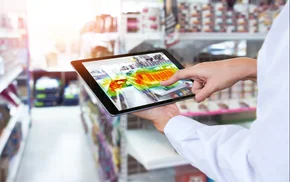These days, data is everything. It impacts virtually every aspect of our lives — from our search engine results to planning the route for our morning commute. This data revolution is transforming the retail landscape too, propelling it towards an exciting new era of ultra-personalisation, efficiency, and innovation. Advanced data analytics and platform technologies are already reinventing how retailers engage with their customers by helping to create deeply tailored experiences. Becoming data-ready, however, isn’t as straightforward as turning a switch. Let’s take a closer look at the role of technologies like analytics, AI, unified platforms, and cybersecurity — which are all crucial to create a seamless and hyper-personalised shopping experience. We’ll also look at opportunities and challenges retailers come across as they navigate this ever evolving landscape, zoom in on how data will transform the world of retail, and explain what is required of retailers.
Retail is experiencing a data revolution

In today’s increasingly competitive retail world, we can no longer ignore the potential of data analytics. Retailers who harness the power of data-driven insights will retain their competitive edge and ensure their businesses have a place in the world of tomorrow.
Data in retail, at a glance
Big data promises to transform the ways in which retailers interact with their customers. This is, to no small extent, because of the unprecedented level of insight it provides. Indeed, data collection is extensive these days, as it enables retailers to develop a 360-degree view of the customer. In an increasingly crowded and competitive market, retailers need to know — with absolute precision — who they are selling to. By combining a variety of data points about their customers, which enables the development of sophisticated marketing strategies, retailers can target customers much more effectively. AI is particularly useful for analytics, as it delivers high-quality insights at unprecedented speed. It identifies major trends and similarities between customer experiences. It can, for instance, pinpoint the root cause of a problem customers are experiencing with the online platform. Omnichannel analytics enables you to garner 360-degree insights into customer purchasing habits. It entails the practice of gathering data from across all channels and touchpoints to create a highly-accurate representation of overall marketing performance. Unlike traditional analytics tools, which focus on single metrics in isolation, omnichannel analytics examines all kinds of customer interactions within a single, comprehensive picture.
These days, data is also indispensable for making forecasts. One of the most common applications of data science in retail is for anticipating demand and identifying trends before they become important. Analytics can also help to optimise online and offline store layout by observing behavioural patterns and psychological responses, and developing insights into how to better match customer preferences. Of course, to accomplish all of these things, a modernised data platform — which can process enormous volumes of data at near-instant speeds — is essential. This enables analysts to immediately identify insights that lead to further action. These platforms also support emerging technologies like generative AI by expanding their intelligence with more raw information.
The power of platform technologies
Platform technologies will play a central role in tomorrow’s data strategies. They unify all of a company’s digital technologies and are indispensable for creating and executing a coherent data strategy. Everything from customer touchpoint analysis, gifting, and payments, to influencer marketing can be done via platform technology. A well-constructed platform can also show margins in advance. While some retailers only see their margins six weeks after the fact, retail AI startups like Puzl enable real-time gross margin visibility weeks in advance, allowing for strategies to be adapted with exceptional agility. Puzl and Woods Supermarkets have, in fact, partnered to develop an AI-based gross margin and advertisement-planning automation platform. This platform can help retailers move quickly and consistently meet or exceed their gross margin targets.
Platforms also enable data consolidation across various platforms so that major trends can be identified. Because of the quantity of data they house, unified platforms also make a great basis for creating forecasts and prediction models. Sports retailer Sportisimo is one example of a company that has taken full advantage of this capacity by utilising Keboola’s integrated ‘dark sky’ API to recalculate their predictions every single day. Because of the nature of their industry, the company’s sales largely depend on anticipating and adapting to changes ranging from weather to seasonal shifts. Through Keboola’s platform, the company can now recalculate 12 million predictions every single day and use this information to adapt their marketing strategies. The outcome of this hyper-aggressive approach was an increase in seasonal sales like skiing equipment, and better agility across all marketing operations.

Renewing IT infrastructure and cybersecurity for modern analytics
With the rise of the Internet of Things (IoT), more data points are being collected than ever before, the handling of which naturally puts pressure on IT. Even the foremost data scientists will struggle if their company’s tech stack does not make good use of software tools. A great infrastructure, for instance, integrates the capacity for open data sharing with generative AI such as Chat-GPT to create new efficiencies and innovative outcomes. It could even integrate extended reality technology. Hardware chain Lowe’s, for instance, has created ‘digital twins’ of some of its stores within the NVIDIA Omniverse Enterprise simulation and collaboration platform. This allows its employees to use a VR headset to interact with a virtual version of the real store and test out scenarios regarding its operations and logistics. The company is planning to take the tech even further, including the implementation of augmented reality X-ray vision. This will enable employees to view items on higher shelves in the real-world stores — without having to climb a ladder to get there.
Another critical aspect of the IT infrastructure is cybersecurity. Failure to responsibly handle customer and employee data could expose retailers to significant financial and reputational penalties. As companies increasingly adopt new checkout methods, including self checkout, biometrics, and digital assets, the pressure on companies to optimise their security methods is higher than ever. Over the last decade, retailers alone have fallen victim to over 10,000 data breaches. Most of these breaches stemmed from vulnerabilities in their payment infrastructure. There are, however, many ways retailers can help protect the sensitive data of their customers and employees, such as data encryption, network segmentation, distributed ledgers, zero trust, and automated systems.
In closing
In today’s hyper-competitive retail world, the potential of data analytics can no longer be ignored. In fact, it must become top-of-mind in retail. Data analytics enable insights that can be implemented at every level of a business’ operation and drive transformative business outcomes. Predictive analytics can help tackle price sensitivity in these challenging times, where rapid inflation and fear of a recession are impacting purchasing habits. Retailers that invest in personalisation tools and leverage customer data can create hyper-personalised marketing strategies that direct customers towards the products they want most. Of course, for data analytics to be harnessed to full effect, a modern unified platform is essential. That also means you need a solid IT infrastructure and robust cybersecurity. Transitioning towards being data-ready may be challenging for retailers still using traditional analytics methods — but the results do seem to speak for themselves.


